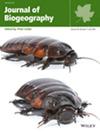Paleoclimate Fluctuations Facilitate the Biogeographical History of Endemic Species of Freshwater Crabs in China via Cycles of Introgressive Hybridisation and Habitat Isolation
Abstract
Aim
The impact of Pleistocene climate fluctuations on the biogeographical history of aquatic species has been a topic of enduring debate. This issue poses particular challenges for parapatric closely related species, especially those situated in transition zones where species assemblages occur between distinct zoogeographic boundaries.
Location
Eastern China.
Taxon
Five closely related Sinopotamon species and subspecies, S. shensiense, S. honanense, S. y. yangtsekiense, S. y. shanxianense, and S. y. tongbaiense.
Methods
These parapatric Sinopotamon species and subspecies, distributed along the boundary between the Palaearctic and Oriental realms in eastern China, offer an ideal model for addressing these challenges. We explored the biogeographic history of these species by conducting a comparative phylogeographic analysis using nine microsatellite loci and two mitochondrial DNA sequences, combined with morphological variation and fine-tuned ecological niche modelling.
Results
Our phylogeographic analyses consistently revealed two well-supported clades: clade A, for S. y. yangtsekiense, and clade B, which includes other species showing polyphyletic patterning and significant gene introgression. The Nanyang Basin and surrounding mountains regions (NBSM) was identified as a critical shared refuge and hybrid zone, facilitating interspecific introgression through at least two putative hybridisation events. During the Late Pleistocene glacial cycles, introgressive hybridisation of these species occurred in the NBSM, followed by rapid expansion and colonisation of heterogenous habitats during interglacial cycles, with dispersal corridors largely aligning with the local river system. In particular, the diffusion corridor of S. honanense significantly disrupted the continuous distribution of S. y. shanxianense and S. y. tongbaiense, indicating that S. honanense has replaced S. y. shanxianense and S. y. tongbaiense in the NYSM and caused a disruption in its distribution.
Main Conclusions
The biogeographic histories of the species in clade B are consistent with a mixing–isolation–mixing model, which suggests that populations experienced repeated introgressive hybridisation during glacial periods and regional habitat isolation during interglacial periods. Our findings represent a classic case of fine tracking biogeographical scenarios in parapatric species and provide unprecedented insights into the evolutionary radiation of the freshwater fauna that occupies zoogeographic boundaries.

 求助内容:
求助内容: 应助结果提醒方式:
应助结果提醒方式:


